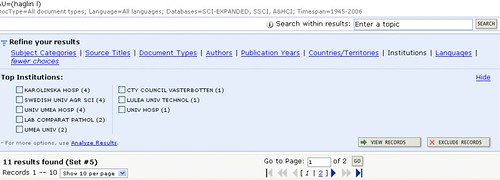At last this project is finished and I apparently survived the final workshop. Hope the attendees were satisfied.
The workshop enticed 3 representatives from Scopus: Ross Cameron, Amanda Hart and Felix Haest and 2 from Thomson ISI: Jeff Klovis and Nicholas Espeche. Cameron has been my contact with Elsevier and my contacts with Thomson has been Nicholas and Simon Pratt (not present at the workshop).
Sometimes it’s hard when doing evaluations of this kind. You never get to meet that guy or girl, often a more technical one, that really knows the most of the product’s inner life. Q’s has often to get filtered through some marketing people, who often need to check with their technichians. But that’s life, and yes, I have some comprehension with that.
So, it was nice meeting Cameron Ross, which I’ve talked to by phone before beside of e-mailing, and Jeff Klovis, who I just had some brief e-mailing with. Jeff came all the way from Piladelphia to answer our questions, and with his 26 years working with WoS he really knows the inner heart of it.
Many thanks to Kari Stange at BIBSAM who led the day so I could focus on my speech and questions at the panel debate. Also, thanks to my swedish advisory board of librarians during this project.
After the talks of Cameron Ross and Jeff Klovis it seems like they really try to overbid each other with new options, coming soon, coming soon. October was a word I heard several times, instead of “next quarter” 😉 If this project One Entry to Research, first initiated by Pelle Olsson, head librarian at KIB, had any impact on the to supplier’s increased attention to new options within their products and their emerging awareness of flaws I don’t know, but at least it was one of the purposes with the project. What I missed is their blog commentaries. Rafael Sidi, engineer at Elsevier, has a blog with a witty title Really Simple Sidi and he writes:
“I am surprised that no one from Scopus and Web of Science is commenting about his remarks about these products. Folks, you like it or not, it’s time to engage and have a conversation with the customers.”
So I hope though this project is finished the debate on this bibliometric and multidisciplinary products could keep on. Will this blog die then? Maybe some postings will still come up, although I have some talks left to do on this subject, I think it’s three. So maybe to stay updated some evaluations will be done the rest of this year. Though there are no government funding left, just my working time at the library.
It would also be nice to here from you readers (if there are any 😉 if you think this blog had any meaning foryour daily work. Just comment pro’s and con’s, I’m glad to have some communications.
As a aftermath to this project I will also try to publish a coverage and overlap study I’ve done with Ylva Gavel. My power point slides from my talk at the workshop will also soon be available from BIBSAM conference hompage.
I will try to update the web page References to literature and a summary of my findings you’ll see at the web page Project summary.
Next week I have 20 minutes to present this project at the 10th European Conference of Medical and Health Libraries, Cluj-Napoca, Romania, 11-16 September. I will also talk about interfaces in the google-era, but for 60 minutes.
P.S. I also had the oppurtunity to improve my non-excellent, but preferbly intelligible written english. Thanks, Ylva Gavel for proofreading some of it.











































You must be logged in to post a comment.